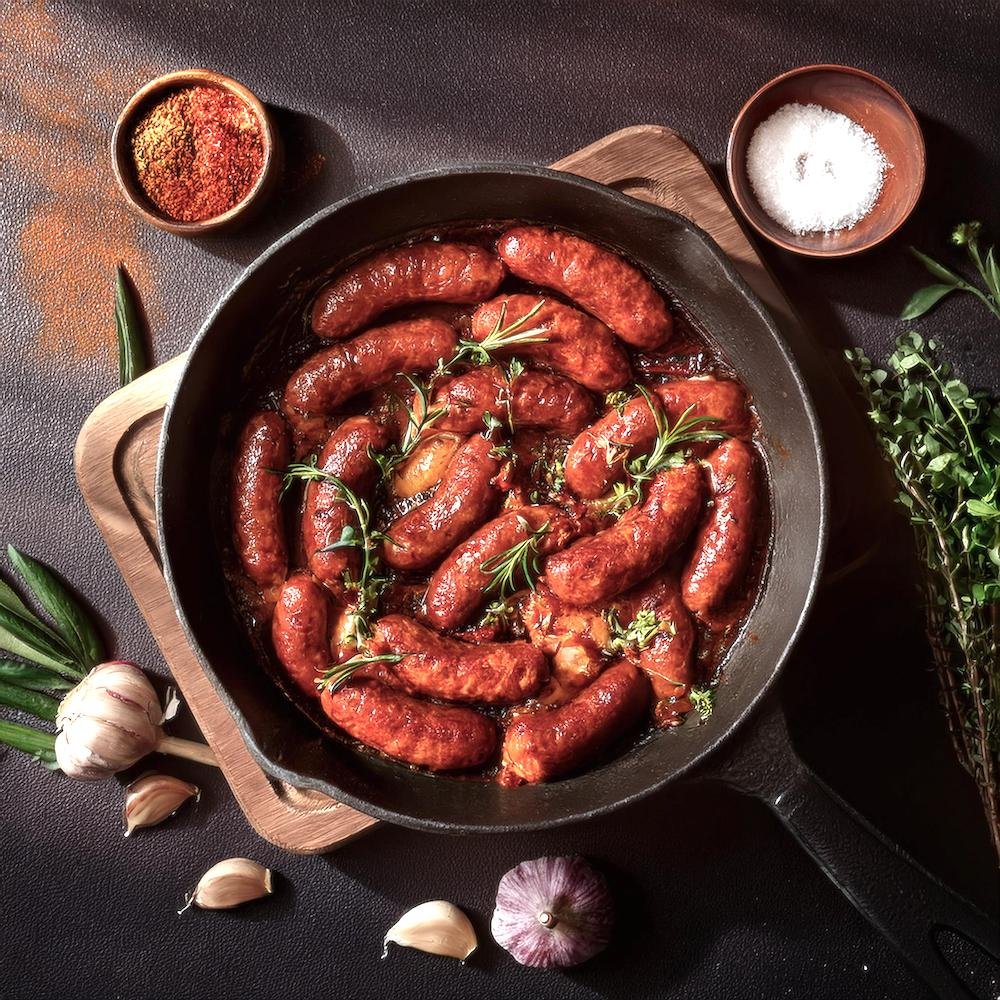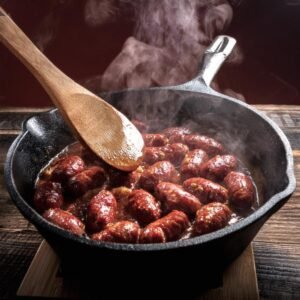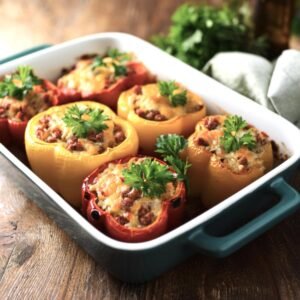What’s the best way to cook beef chorizo? Beef chorizo is a versatile and flavorful ingredient that can elevate any dish with its bold, smoky, and spicy taste. From breakfast hashes to tacos and casseroles, cooking beef chorizo to perfection is key to unlocking its full potential.
Whether you’re pan-frying it for a quick meal, grilling sausages for a BBQ, or baking it into a hearty dish, the right cooking method ensures the best texture and flavor. Learning how to cook beef chorizo properly also allows you to avoid common mistakes like overcooking or using too much oil.
In this guide, we’ll explore the best ways to cook beef chorizo, step-by-step instructions, and tips to help you create delicious meals every time.
Why Proper Cooking Matters
Properly cooking beef chorizo is essential for safety, flavor, and texture.
Ensuring Food Safety
- Raw Chorizo:
- Most beef chorizo is sold raw and needs to be fully cooked to an internal temperature of 160°F (71°C).
- Cooking thoroughly ensures that harmful bacteria are eliminated.
Pro Tip: Use a meat thermometer to check for doneness, especially when cooking chorizo sausages.
Enhancing Flavor and Texture
- Flavor Development:
- Cooking releases the natural oils and spices in beef chorizo, enhancing its smoky and spicy flavor.
- Browning the chorizo creates a savory depth that complements other ingredients.
- Texture Control:
- Proper cooking ensures a juicy and tender texture, whether you’re working with loose chorizo or sausage links.
Pro Tip: Avoid overcooking, as it can dry out the chorizo and make it less flavorful.
Preparation Before Cooking
Preparing beef chorizo properly before cooking is essential to achieve the best results. Whether you’re using loose chorizo or sausage links, these steps will help ensure your dish turns out flavorful and perfectly cooked.
Remove Casing for Loose Chorizo
- Why It’s Important:
- If your beef chorizo comes in sausage casings and you plan to use it for tacos, hashes, or casseroles, removing the casing allows the meat to cook evenly and break apart easily.
- How to Do It:
- Use a sharp knife to make a shallow cut along the length of the casing.
- Peel the casing away from the meat and discard it.
Pro Tip: If you’re grilling or baking chorizo sausages, leave the casing intact to help retain the shape.
2. Preheat Your Pan, Grill, or Oven
- Why It’s Important:
- Preheating ensures even cooking and helps the chorizo brown properly, which enhances its flavor.
- How to Preheat:
- Pan: Heat a non-stick or cast-iron skillet over medium heat for 2–3 minutes.
- Grill: Preheat your grill to medium heat (about 375–400°F or 190–200°C).
- Oven: Preheat your oven to 375°F (190°C) for baked dishes.
Pro Tip: Avoid using high heat, as it can cause the chorizo to cook unevenly or burn.
3. Adjust Seasoning
- Why It’s Important:
- Beef chorizo is already heavily seasoned with spices like paprika, garlic, and chili powder, so additional seasonings may not be necessary.
- How to Balance Flavors:
- Taste test the cooked chorizo before adding extra spices to your dish.
- Pair it with neutral ingredients like rice, beans, or potatoes to balance the bold flavors.
Pro Tip: If the chorizo is too salty, pair it with unsalted ingredients to reduce the overall sodium in the dish.
4. Gather Cooking Tools
- Essentials:
- Skillet or grill for frying and grilling.
- Baking dish for casseroles or stuffed recipes.
- Meat thermometer to check internal temperature.
Pro Tip: Use a wooden spoon or spatula for stirring loose chorizo to avoid scratching non-stick pans.
Best Ways to Cook Beef Chorizo

Beef chorizo is incredibly versatile and can be cooked using a variety of methods. Whether you’re pan-frying it for a quick meal, grilling it for a smoky finish, or baking it into a casserole, each method brings out its bold flavors in unique ways.
1. Pan-Frying
- Why It’s Great:
- Pan-frying is the quickest and most common method for cooking loose beef chorizo. It ensures even browning and allows the natural oils and spices to develop fully.
- How to Do It:
- Preheat a skillet over medium heat.
- Add the beef chorizo (no extra oil is needed, as the chorizo releases its own fat).
- Break the meat into small pieces with a wooden spoon or spatula.
- Cook for 8–10 minutes, stirring occasionally, until fully browned and cooked through.
Pro Tip: Use the rendered fat to sauté onions, peppers, or garlic for added flavor in your dish.
2. Grilling
- Why It’s Great:
- Grilling chorizo in casing creates a crispy exterior while keeping the inside juicy and flavorful.
- How to Do It:
- Preheat the grill to medium heat (375–400°F or 190–200°C).
- Place chorizo sausages directly on the grill grates.
- Cook for 8–10 minutes, turning occasionally, until the casing is browned and the internal temperature reaches 160°F (71°C).
Pro Tip: Serve grilled chorizo with roasted vegetables or in a bun for a flavorful sausage sandwich.
3. Baking
- Why It’s Great:
- Baking is ideal for incorporating beef chorizo into casseroles, stuffed dishes, or meal prep. It evenly cooks the meat while blending flavors with other ingredients.
- How to Do It:
- Preheat the oven to 375°F (190°C).
- Crumble or slice the chorizo and place it in a baking dish.
- Combine it with ingredients like rice, beans, vegetables, or cheese.
- Bake for 25–30 minutes, until the dish is heated through and the chorizo is cooked.
Pro Tip: For casseroles, cover with foil for the first 15 minutes to prevent drying out, then remove the foil for a golden finish.
4. Simmering in Soups or Stews
- Why It’s Great:
- Adding chorizo to soups or stews infuses the broth with its smoky, spicy flavors.
- How to Do It:
- Brown the chorizo in a skillet before adding it to the soup or stew.
- Simmer with the rest of the ingredients for 20–30 minutes to allow the flavors to meld.
Pro Tip: Use chorizo in chili, pozole, or lentil soup for a flavorful twist.
5. Roasting
- Why It’s Great:
- Roasting chorizo with vegetables creates a caramelized, smoky flavor.
- How to Do It:
- Preheat the oven to 400°F (200°C).
- Toss sliced chorizo with diced potatoes, onions, and bell peppers on a baking sheet.
- Roast for 20–25 minutes, stirring halfway through.
Pro Tip: Finish with a sprinkle of fresh herbs like parsley or cilantro for a burst of color and flavor.
Common Mistakes to Avoid
Cooking beef chorizo can be simple, but there are a few pitfalls that can affect its flavor, texture, and overall success in your dishes. Here are the most common mistakes and how to avoid them.
1. Overcooking the Chorizo
- Why It’s a Problem:
- Overcooking can cause beef chorizo to become dry, tough, and lose its rich, smoky flavor.
- How to Avoid It:
- Cook loose chorizo over medium heat and stir occasionally to ensure even cooking.
- For sausage links, use a meat thermometer to check that the internal temperature reaches 160°F (71°C) and no higher.
Pro Tip: Remove chorizo from heat as soon as it’s fully cooked to preserve its juiciness.
2. Using Too Much Oil
- Why It’s a Problem:
- Beef chorizo releases natural fats as it cooks, so adding extra oil can make the dish overly greasy.
- How to Avoid It:
- Skip the oil when pan-frying chorizo, as it provides enough fat for cooking.
- If there’s excess grease in the pan, drain it before adding other ingredients.
Pro Tip: Use a paper towel to blot away extra grease for a cleaner, lighter dish.
3. Skipping Preparation Steps
- Why It’s a Problem:
- Not removing casings (for loose chorizo) or preheating the pan can lead to uneven cooking.
- How to Avoid It:
- Always remove casings if you’re using chorizo as crumbles in tacos or hashes.
- Preheat your pan, grill, or oven for even heat distribution.
Pro Tip: Keep your ingredients and tools ready to ensure a smooth cooking process.
4. Ignoring Flavor Pairings
- Why It’s a Problem:
- Beef chorizo’s bold flavor can overpower dishes if not balanced with complementary ingredients.
- How to Avoid It:
- Pair chorizo with neutral or mildly flavored ingredients like rice, beans, or potatoes.
- Include fresh elements like citrus, avocado, or herbs to add brightness and balance.
Pro Tip: Add a dollop of sour cream or a squeeze of lime to tone down the spice if needed.
5. Not Breaking It Apart While Cooking
- Why It’s a Problem:
- Loose chorizo can clump together, leading to uneven cooking and texture.
- How to Avoid It:
- Use a wooden spoon or spatula to break up the chorizo into smaller pieces while it cooks.
Pro Tip: Stir frequently to ensure even browning and a consistent texture throughout.
Recipes Featuring Cooked Beef Chorizo
Beef chorizo’s versatility makes it a star ingredient in many dishes, from breakfast staples to hearty dinners. Here are some delicious recipes to inspire your cooking.
1. Beef Chorizo Tacos
- Why It Works:
- The smoky and spicy flavors of beef chorizo are perfect for tacos.
- How to Make It:
- Cook beef chorizo in a skillet until browned.
- Fill warm corn or flour tortillas with the cooked chorizo.
- Add toppings like diced onions, cilantro, avocado, and a squeeze of lime.
Pro Tip: Pair with fresh salsa or a dollop of sour cream to balance the heat.
2. Breakfast Hash with Beef Chorizo
- Why It Works:
- Chorizo adds bold flavor to this comforting breakfast dish.
- How to Make It:
- Sauté diced potatoes until crispy.
- Add cooked chorizo and mix to combine.
- Top with fried or scrambled eggs and garnish with fresh herbs.
Pro Tip: Include bell peppers and onions for extra flavor and texture.
3. Chorizo-Stuffed Bell Peppers
- Why It Works:
- The sweetness of bell peppers complements the spiciness of chorizo.
- How to Make It:
- Halve and hollow out bell peppers.
- Mix cooked chorizo with rice, beans, or quinoa, and stuff the peppers.
- Bake at 375°F (190°C) for 20–25 minutes until the peppers are tender.
Pro Tip: Sprinkle cheese on top before baking for a melty, delicious finish.
4. Chorizo Chili
- Why It Works:
- Chorizo enhances the depth of flavor in chili recipes.
- How to Make It:
- Brown chorizo in a pot, then add onions, garlic, and diced tomatoes.
- Stir in beans, chili powder, cumin, and beef broth.
- Simmer for 30–40 minutes and serve with cornbread or tortilla chips.
Pro Tip: Add a splash of lime juice before serving to brighten the flavors.
5. Chorizo Pasta
- Why It Works:
- Chorizo pairs beautifully with creamy or tomato-based sauces.
- How to Make It:
- Cook chorizo in a skillet and set aside.
- Prepare pasta and toss with a tomato or cream sauce.
- Mix in the cooked chorizo and garnish with Parmesan cheese and fresh basil.
Pro Tip: Use penne or rigatoni to catch the chorizo bits and sauce.
6. Chorizo Pizza
- Why It Works:
- Chorizo’s bold flavor adds a unique twist to pizza.
- How to Make It:
- Spread marinara sauce on pizza dough.
- Top with cooked chorizo, shredded cheese, and diced vegetables.
- Bake at 425°F (220°C) until the crust is golden and the cheese is bubbly.
Pro Tip: Garnish with fresh cilantro or a drizzle of sour cream for added flair.
FAQs:
What Is the Best Way to Cook Beef Chorizo?
Method: The best way to cook beef chorizo is by pan-frying it over medium heat. This method allows the natural oils to release, enhancing the flavor while browning the meat evenly.
Steps: Preheat a skillet over medium heat (no additional oil needed).
Add the chorizo and break it into small pieces using a wooden spoon.
Cook for 8–10 minutes, stirring occasionally, until fully browned.
Pro Tip: Use the rendered fat from the chorizo to sauté vegetables or eggs for added flavor.
How Is Chorizo Supposed to Be Cooked?
Fully Cooked: Most beef chorizo is sold raw and must be cooked thoroughly until the internal temperature reaches 160°F (71°C).
Chorizo can be cooked loose or in its casing, depending on the recipe.
Visual Cues: The meat should be browned evenly, and any excess fat should render out.
If cooking sausages, the casing should be firm and slightly crispy.
Pro Tip: Stir the chorizo frequently while cooking to ensure even browning.
Do You Fry or Bake Chorizo?
Both Methods Work: Frying: Ideal for loose chorizo or breaking up sausage into crumbles. Quick and effective for tacos, hashes, or casseroles.
Baking: Great for dishes like stuffed peppers or casseroles where chorizo is combined with other ingredients.
Pro Tip: Choose frying for quick meals and baking for layered, slow-cooked recipes.
How to Cook Chorizo Without Drying It Out?
Tips to Retain Moisture: Use medium heat to avoid overcooking and drying out the meat.
If cooking sausage links, avoid piercing the casing to keep the juices intact.
For loose chorizo, add a small splash of water or broth during cooking to keep it moist.
Pro Tip: Remove chorizo from heat as soon as it’s cooked through to maintain its juiciness.
Suggested Internal Links:
- Is Beef Chorizo Already Cooked?
Understand the differences between raw and pre-cooked beef chorizo and how to prepare them. - What Can Be Made from Date Palm?
Discover how date palms can be used in complementary dishes with beef chorizo. - Garlic Parmesan Chicken Pasta
Explore how to incorporate cooked beef chorizo into creamy pasta dishes for a smoky flavor. - What Are the Five Mistakes to Avoid Pasta Salad?
Learn how to pair beef chorizo with pasta salads while avoiding common preparation errors. - What Is Mexican Salad Made Of?
Pair beef chorizo with a refreshing Mexican salad for a balanced, flavorful meal.
Conclusion About What’s the best way to cook beef chorizo?
Cooking beef chorizo to perfection is all about choosing the right method and being mindful of its bold flavors. Whether you’re pan-frying it for tacos, grilling it for sausages, or baking it into casseroles, the key is to balance heat and timing to retain its rich, smoky, and spicy taste.
The best way to cook beef chorizo depends on the dish you’re preparing. Pan-frying is quick and versatile, grilling adds a smoky char, and baking works beautifully for layered recipes. By avoiding common mistakes like overcooking or using too much oil, you can ensure your chorizo stays flavorful and moist.
From breakfast hashes to dinner casseroles, beef chorizo adds depth and excitement to a variety of meals. With these tips and techniques, you’re ready to explore the endless possibilities of this delicious ingredient. Happy cooking!
Discover more mouthwatering recipes on our Web Site ! Stay connected and get inspired by following us on Facebook, Instagram, Pinterest, and Twitter for the latest updates!



